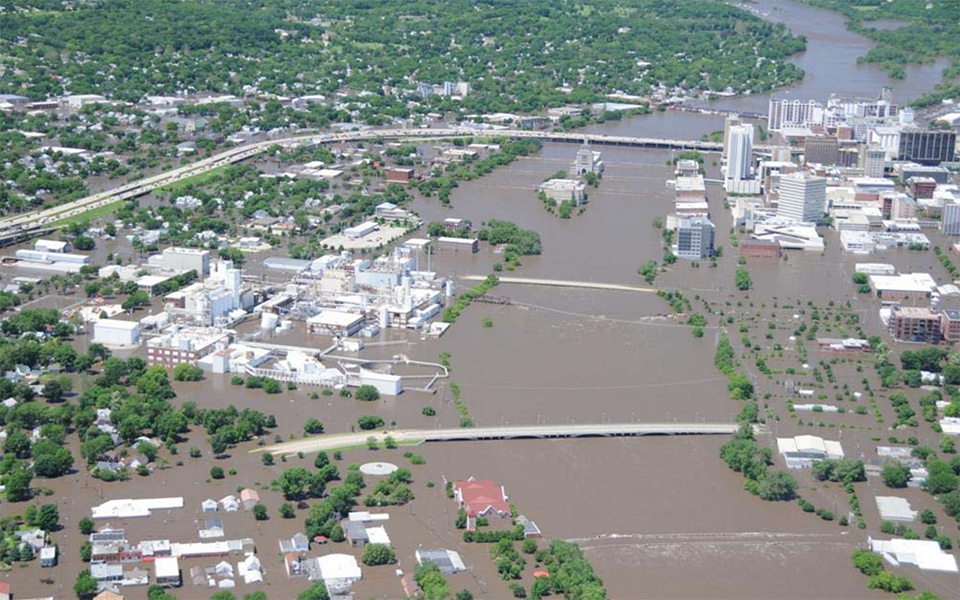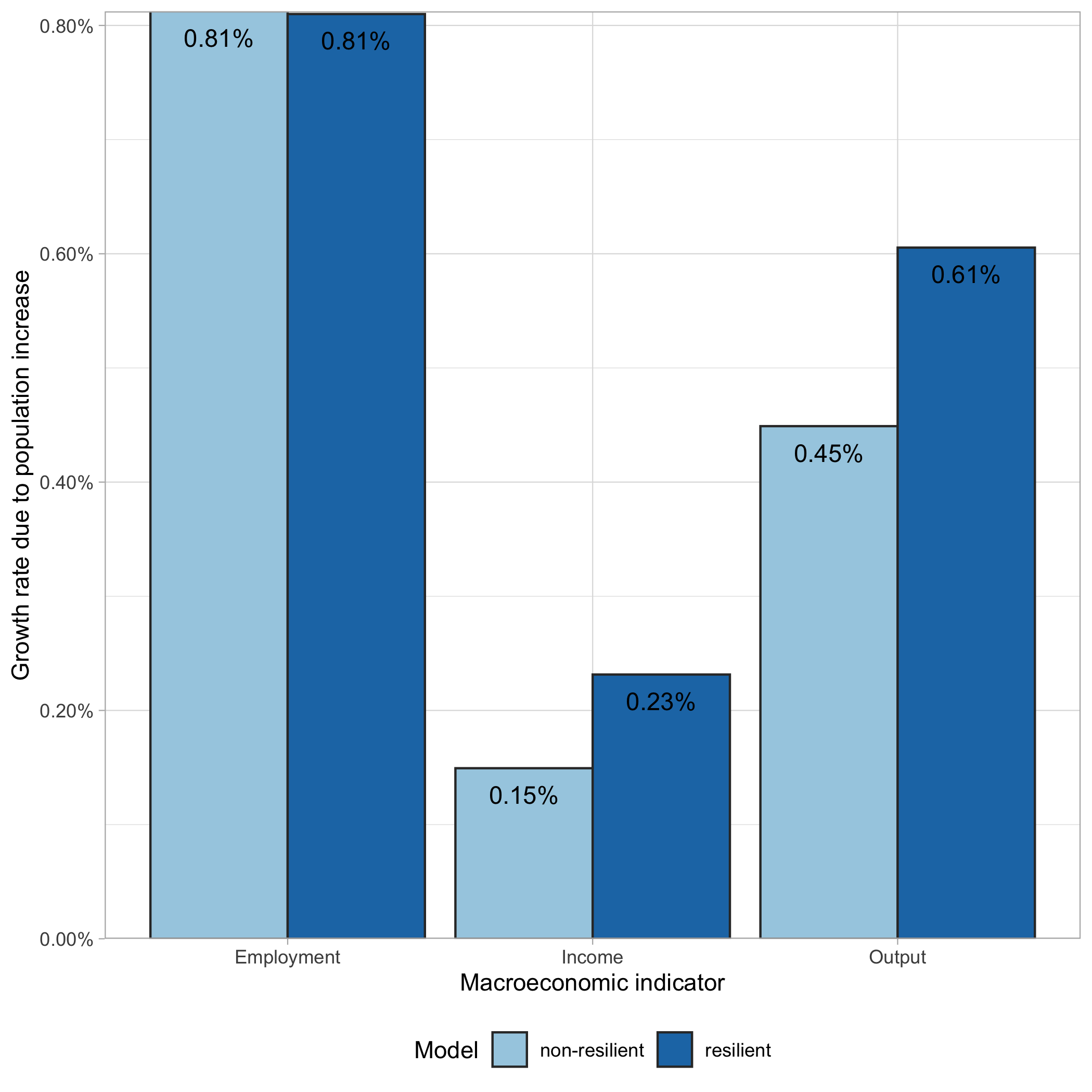Taking Measure
Just a Standard Blog

View of Downtown Cedar Rapids, Iowa, on June 13, 2008, a day after record flooding of the Cedar River devastated much of the city.
Many cities in the United States have experienced or will experience devastating losses caused by a natural disaster. In the aftermath of a disaster, the question communities grapple with is how to invest in recovery. Understandably, the focus tends to be on building back as quickly as possible. But it may actually make more economic sense to rebuild better than before.
In June 2008, the Midwestern United States experienced severe riverine flooding, a result of heavy rainfall atop soils oversaturated from heavy winter snowfall and an unusually wet spring. The Cedar River in Cedar Rapids, Iowa, crested at over 9.4 meters (31 feet) — a level that far exceeded the previous record set in March 1961. The flooding resulted in an estimated $5.4 billion in losses, affecting about 14% of the city’s buildings and infrastructure. Fortunately, the city avoided any flood-related fatalities.
The city of Cedar Rapids asked its citizens what the best course of action should be going forward. Over the next 10 months, the city developed a community-led framework to not only recover from the flood, but also become resilient to future flooding. At the core of the framework is an extensive flood-control system, a 20-year capital project that is estimated to cost $550 million. In addition, the framework emphasized neighborhood revitalization through commercial and residential development to attract a younger, more dynamic workforce. In other words, the citizens of Cedar Rapids chose to rebuild better.
No city would argue that building back better is undesirable, but the typical calculation communities face assumes that the only benefit from investing in resilience is preventing another disaster. It may be difficult to justify the huge upfront cost of such long-term investments, especially in the aftermath of a disaster when the priority is recovery.
However, the focus on simple recovery is often based on the miscalculation that so-called 500-year floods, like the one Cedar Rapids experienced, are rare and unlikely to repeat more often. The truth is that there is a 0.2% chance that one of these floods could strike every year. While it is a small chance, it is worth considering in the investment decision. As the Cedar Rapids example illustrates, investing in resilience is an opportunity to foster a safe environment for business and a more vibrant economy.
Such benefits that accrue in the absence of a disaster are called “resilience dividends,” a term coined by Judith Rodin. Resilience dividends can help communities make a business case for building back better. But to date, there is very little literature on how to measure resilience dividends. Without a way to measure them, they likely will not be incorporated into a community’s calculations.
In research with colleagues at NIST and Colorado State University, I use economic simulation methods to measure resilience dividends in Cedar Rapids. The idea is simple: to compare the economy of a “resilient” Cedar Rapids to a “non-resilient” Cedar Rapids. The question I ask is whether a resilient model of Cedar Rapids creates any measurable non-disaster benefits that a non-resilient model of Cedar Rapids does not. Because the two models of Cedar Rapids differ only in terms of the investment in resilience, we can attribute the value of any additional benefits as a resilience dividend.
Using so-called computable general equilibrium models, which simulate the intricacies of supply and demand in a market economy, I can examine the direct and indirect impacts of a simple thought experiment on Cedar Rapids.
The thought experiment is as follows. Assuming one of the goals of neighborhood revitalization is to both keep current residents and attract new residents, a natural question is whether a resilient Cedar Rapids can better absorb a larger population than a non-resilient Cedar Rapids. In this thought experiment, a 2% average population growth increase represents a non-disaster shock to both cities that has the potential to improve their economies. The question is, by how much?
I consider the impacts of more people moving to the city on three key macroeconomic indicators: employment, income and output (gross domestic product or GDP of the city). I find, based on the simulation models, that a resilient Cedar Rapids experiences higher output and income growth than a non-resilient Cedar Rapids. In other words, investing in resilience yields resilience dividends in output and household income. Interestingly, the impact on employment is the same; that is, the resilience dividend for employment is zero, meaning that both resilient and non-resilient Cedar Rapids were able to fill jobs from the new labor coming to the city.

To put these results into dollar terms, let’s consider output. Output growth in resilient Cedar Rapids is 0.61%, compared with 0.45% output growth in non-resilient Cedar Rapids. If both model cities had grown at the same rate, non-resilient Cedar Rapids would have produced an additional $11 million in output. Similarly, the 0.23% growth rate in income means households in non-resilient Cedar Rapids are losing out on almost $3 million.
The reasons for these differences in output and income growth are resilience dividends springing from the investments in the revitalization of the downtown area in Cedar Rapids and in industries that the city wanted to grow.
More work remains to be done. The flood-control system, construction of which began in earnest in 2016, is a work in progress and far from complete. Once there is substantial flood protection, my colleagues and I will revisit measuring resilience dividends in Cedar Rapids. In the meantime, I hope that these methods can be useful for communities that want to articulate a business case for rebuilding better than before.
About the author
Related Posts
Comments
Interesting timing for this article (2008 flood). Cedar Rapids NOW needs a quick emergency response to recover from the derecho winds that ravaged the area...






Thought-provoking write up with facts